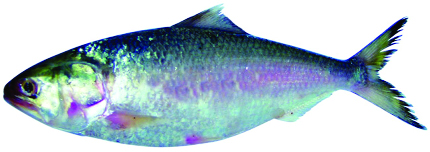
Olivia VF Chaudhury :
As Pohela Boishakh approaches, Bangladeshis nationwide set out to fish markets to purchase the staple dish of this cherished cultural holiday: a plump, juicy Padma hilsa. However, consumer demand for this beloved delicacy has placed it at serious risk from overfishing.
Growing buying power for the Bangladeshi population has caused an influx of purchasing
delicacies such as the hilsa. This skyrocketing demand has caused fishermen to dramatically increase their catch rate. “We know the hilsa is at risk,” says Prollad Rajbongshi, a fishmonger from Savar. “We still have to survive. Approximately 9 out of 10 houses want hilsa. It’s a huge portion of my income. We’ve raised prices of the hilsa because of the increasing sales, but that has not stopped the demand, which has been a boon for us. We’ve had to nearly double and triple our catching efforts.”
Encouragingly, the government has taken strong measures to combat hilsa overfishing. Government efforts include the protection of the jatka (hilsa fry) by ratifying the Fish Conservation Act of 1950 to include that no person shall carry, transport, barter, sell, or possess jatka. Furthermore, the Department has banned the capture of hilsa during its spawning period in October. “The hilsa accounts for 1% of Bangladesh’s GDP,” states Dr. Syed Arif Azad, Director General of the Department of Fisheries. “We are working towards making serious conservation efforts.” These efforts have paid off tremendously. Since 2009, when the new laws were established, the hilsa population has jumped from 298,000 lakh tons to 351,000 lakh tons in 2013. Strict repercussions have kept illegal fishing at bay. “If boats are caught illegally fishing for hilsa, they are forfeited and auctioned,” says Dr. Azad. “The fishes seized from these fishing boats are then distributed free of charge to orphanages.”
The sanctions on the hilsa have had a surprisingly minimal impact on the fishermen. “Yes, we have suffered losses, but they have been minimal because we keep the hilsa in cold storage. During the rainy season, when there are plenty of hilsa, we catch extra to keep in cold storage for the dry months. We also increase our sales of other fish like rui, pangash, katla and bual,” says Rajbongshi.
Awareness of the plight of the hilsa is reaching consumers. Niger Rahman, a working mother of two living in Dhaka, says she is aware of the risk and tries to do her part by modifying her family’s consumption of hilsa. She substitutes hilsa with other fish such as mackerel during the dry season. However, no other fish can replace the hilsa. “If the hilsa were to go extinct tomorrow, it would be disastrous for the people,” says Ms. Rahman. “No fish can substitute the hilsa. It is unique. It’s more than just a fish, it represents the traditions and culture of the Bengali people.”
As Pohela Boishakh approaches, Bangladeshis nationwide set out to fish markets to purchase the staple dish of this cherished cultural holiday: a plump, juicy Padma hilsa. However, consumer demand for this beloved delicacy has placed it at serious risk from overfishing.
Growing buying power for the Bangladeshi population has caused an influx of purchasing
delicacies such as the hilsa. This skyrocketing demand has caused fishermen to dramatically increase their catch rate. “We know the hilsa is at risk,” says Prollad Rajbongshi, a fishmonger from Savar. “We still have to survive. Approximately 9 out of 10 houses want hilsa. It’s a huge portion of my income. We’ve raised prices of the hilsa because of the increasing sales, but that has not stopped the demand, which has been a boon for us. We’ve had to nearly double and triple our catching efforts.”
Encouragingly, the government has taken strong measures to combat hilsa overfishing. Government efforts include the protection of the jatka (hilsa fry) by ratifying the Fish Conservation Act of 1950 to include that no person shall carry, transport, barter, sell, or possess jatka. Furthermore, the Department has banned the capture of hilsa during its spawning period in October. “The hilsa accounts for 1% of Bangladesh’s GDP,” states Dr. Syed Arif Azad, Director General of the Department of Fisheries. “We are working towards making serious conservation efforts.” These efforts have paid off tremendously. Since 2009, when the new laws were established, the hilsa population has jumped from 298,000 lakh tons to 351,000 lakh tons in 2013. Strict repercussions have kept illegal fishing at bay. “If boats are caught illegally fishing for hilsa, they are forfeited and auctioned,” says Dr. Azad. “The fishes seized from these fishing boats are then distributed free of charge to orphanages.”
The sanctions on the hilsa have had a surprisingly minimal impact on the fishermen. “Yes, we have suffered losses, but they have been minimal because we keep the hilsa in cold storage. During the rainy season, when there are plenty of hilsa, we catch extra to keep in cold storage for the dry months. We also increase our sales of other fish like rui, pangash, katla and bual,” says Rajbongshi.
Awareness of the plight of the hilsa is reaching consumers. Niger Rahman, a working mother of two living in Dhaka, says she is aware of the risk and tries to do her part by modifying her family’s consumption of hilsa. She substitutes hilsa with other fish such as mackerel during the dry season. However, no other fish can replace the hilsa. “If the hilsa were to go extinct tomorrow, it would be disastrous for the people,” says Ms. Rahman. “No fish can substitute the hilsa. It is unique. It’s more than just a fish, it represents the traditions and culture of the Bengali people.”

